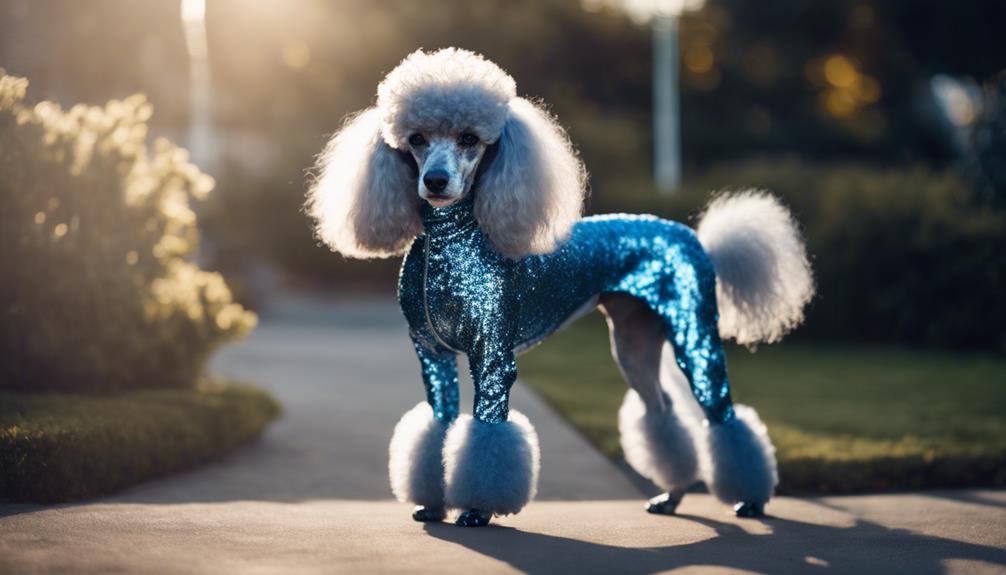Step into the sophisticated world of silver and blue poodles, where the shimmering shades and beguiling beauty of these canine companions await your exploration. Intrigued by their mysterious allure and elegant demeanor, you'll uncover the secrets behind their unique coat colors and the intriguing distinctions between them. As you unravel the complexities of silver and blue poodles, a deeper understanding of their captivating charm and enigmatic allure will unfold before your eyes, inviting you to discover the hidden depths of their mystique.
Key Takeaways
- Silver and blue poodles exhibit unique color variations, with silver poodles fading faster and having a lighter hue than blue poodles.
- Genetic testing aids in predicting offspring colors accurately, crucial for breeding decisions.
- Regular grooming is vital for silver and blue poodles to maintain coat health and appearance.
- Bathing, drying, and proper coat maintenance techniques are essential for preserving the beauty of silver and blue poodle coats.
Silver and Blue Poodles Overview
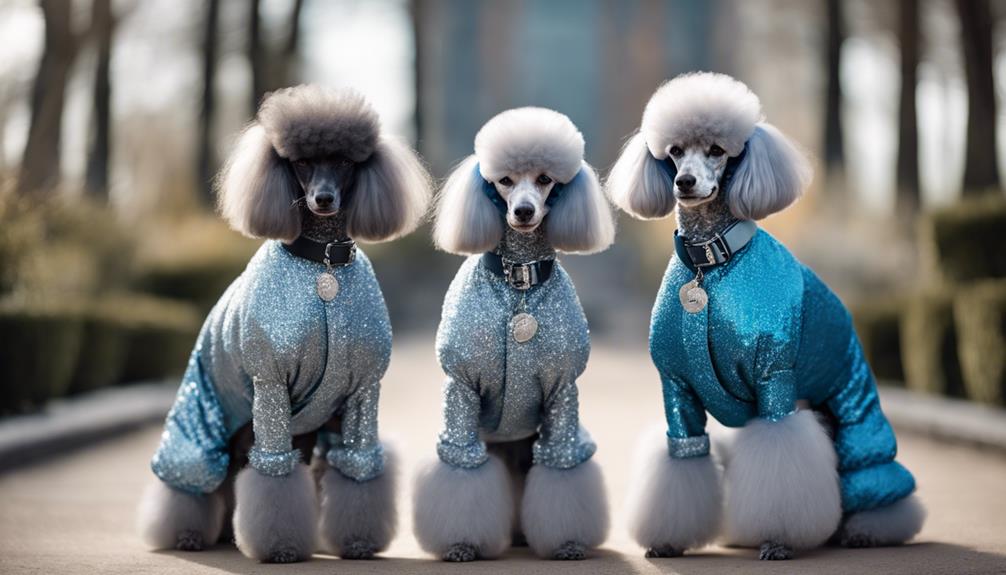
When delving into the captivating world of silver and blue poodles, it becomes evident that their distinct characteristics and color variations set them apart within the poodle breed. For first-time poodle enthusiasts, understanding the differences between silver and blue poodles can be an exciting journey. Silver poodles, known for their platinum faces as puppies, gradually lighten to reveal a stunning silver coat. In contrast, blue poodles like Roxy possess a gunmetal grey hue that distinguishes them from their silver counterparts.
For those encountering silver and blue poodles for the first time, it might be surprising to learn that both colors start as black and then lighten over time. However, silver poodles tend to fade faster than their blue counterparts, resulting in unique color transformations that add to their mystique. Roxy, a prime example of a true blue poodle, showcases the distinct shade differences between blue and silver coats. By observing these color characteristics and visual variances, one can truly appreciate the individuality of silver and blue poodles within the poodle community.
Genetics of Silver and Blue Poodles
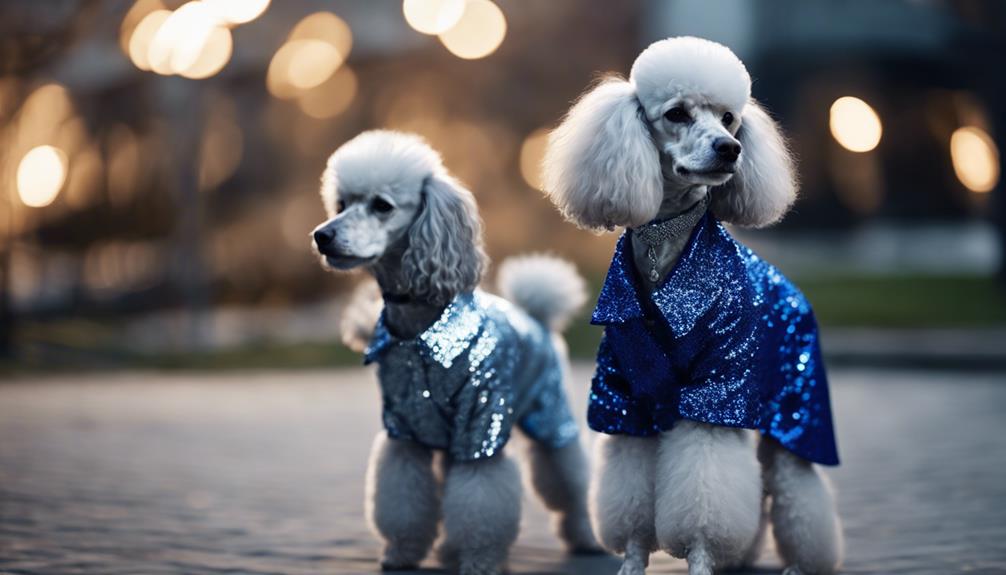
When considering the genetics of silver and blue poodles, it's essential to understand how coat color inheritance works in these unique breeds. Genetic testing options are available to pinpoint the specific genes responsible for the dilution of black pigment in silver and blue poodles, aiding breeders in making informed decisions about future litters. By unraveling the genetic intricacies behind silver and blue coat colors, you can gain insights into the inheritance patterns and predict potential coat outcomes with greater accuracy.
Coat Color Inheritance
In the genetics of silver and blue poodles, the presence of the dilute gene (dd) plays a crucial role in determining the unique coat colors of these elegant canines. Silver poodles inherit the dilute gene from both parents, resulting in a lighter coat color, while blue poodles inherit it from one parent, leading to a steel blue or gunmetal grey hue. This gene affects the eumelanin pigment in poodle coats, creating the silver and blue variations. Understanding coat color inheritance helps predict the potential colors of silver and blue poodle offspring. Genetic testing can confirm the dilute gene's presence and predict the coat colors of silver and blue poodle puppies accurately.
Genetic Testing Options
To explore the genetics of silver and blue poodles further, consider the available genetic testing options that can confirm the presence of dilution genes responsible for these distinctive coat colors. Genetic testing can identify specific markers associated with silver and blue hues in Standard Poodles. Breeders can utilize these tests to comprehend the inheritance patterns of silver and blue coat colors, aiding in making informed breeding decisions. By determining whether a poodle carries the genes for silver or blue coloration through genetic testing, breeders can strategically plan matings to maintain and enhance these unique coat colors within the poodle population. Understanding the genetic makeup of silver and blue poodles is crucial for preserving the integrity and beauty of these coat variations in Standard Poodles.
Coat Color Variations
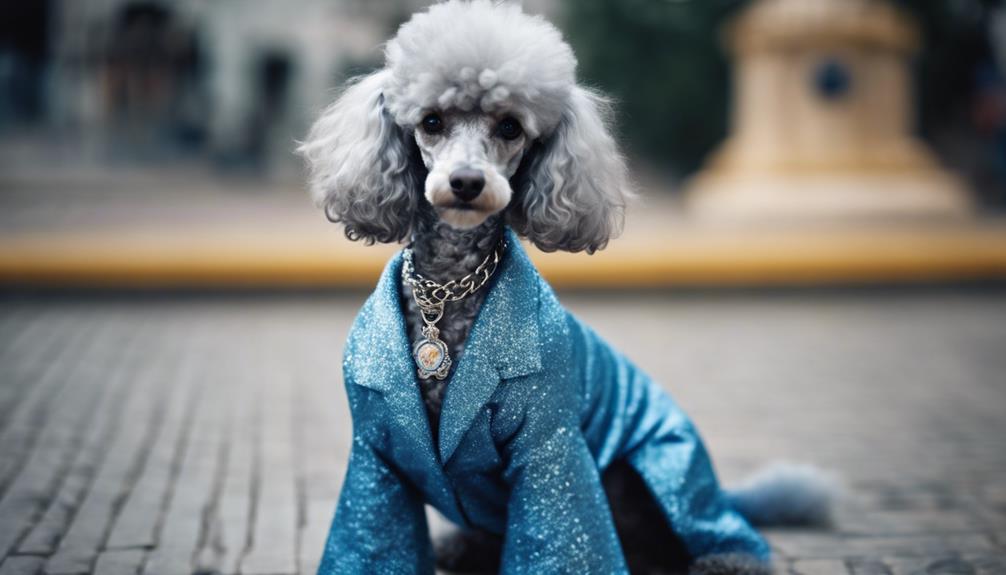
Silver and blue poodles showcase rare and enchanting coat color variations. While silver poodles have a lighter hue compared to blue poodles, blue poodles take longer to develop their final color. Understanding the nuances of these coat color variations adds to the mystique of silver and blue poodles.
Rare Silver Poodles
Amidst the spectrum of poodle coat colors, rare silver poodles captivate with their unique and intriguing variations. As puppies, silver poodles start as black with a bright platinum face, showcasing a stunning contrast during their early stages. Unlike blue poodles, silver poodles tend to fade faster over time, resulting in a lighter overall color in adulthood. The transformation process of silver poodles, known as 'Cosmo,' is a fascinating journey that sets them apart. Their coat color variations make them truly stand out among other poodle colors, offering a distinctive and elegant appearance. If you're considering adding a poodle to your family, the rare silver poodle is sure to bring a touch of sophistication and charm to your home.
Enchanting Blue Hues
Exploring the realm of coat color variations in poodles reveals the enchanting blue hues that captivate admirers with their distinct allure. At a young age, blue poodles like Roxy start as black and transition into a mesmerizing gunmetal grey shade. Unlike silver poodles that may fade, blue poodles like Roxy maintain their vibrant color. Some enthusiasts mistakenly refer to lighter-hued bad black poodles as blue, but true blue poodles, like Roxy, boast a lighter and more captivating blue shade. Roxy, a classic blue poodle, showcases a color that is lighter than Dexter's and clearly distinguishes her from silver poodles. The unique charm of these enchanting blue hues adds a touch of elegance to the poodle world.
Understanding Poodle Grooming Needs
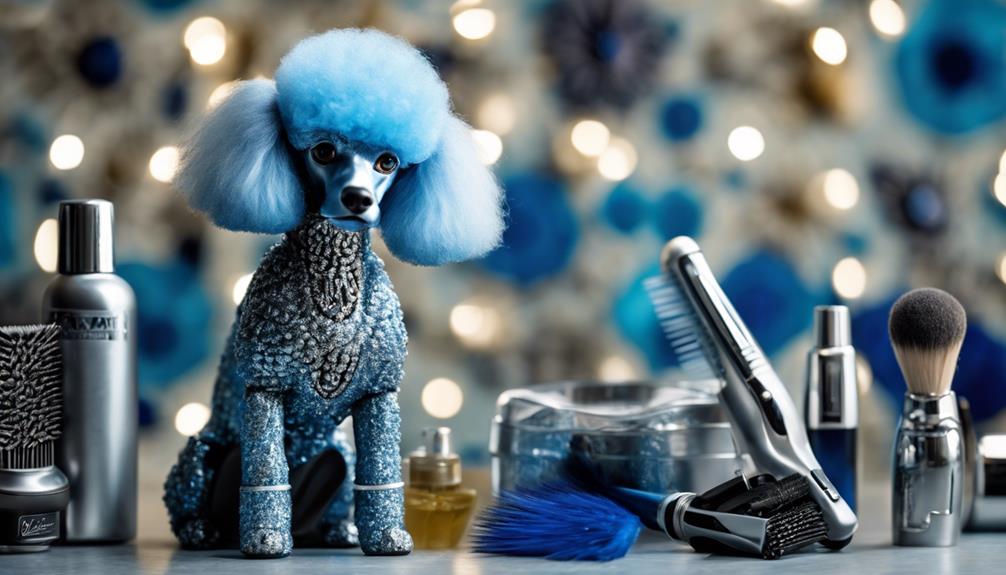
To properly care for silver and blue poodles, understanding their unique grooming needs is essential for maintaining their coat health and appearance. Poodles with silver or blue coats require regular grooming to preserve their color and texture. This grooming includes tasks such as regular baths, brushing, and trimming to prevent matting and tangling. Using specific grooming tools like slicker brushes, metal combs, and grooming shears is crucial for effectively maintaining the coats of silver and blue poodles. In some cases, professional grooming services may be necessary for intricate tasks like shaping the coat and preserving color vibrancy. By comprehending the distinct grooming requirements of silver and blue poodles, you can ensure that their coats remain healthy and beautiful. Remember, regular grooming not only enhances the aesthetic appeal of your poodle but also contributes to their overall well-being.
Bathing and Drying Techniques
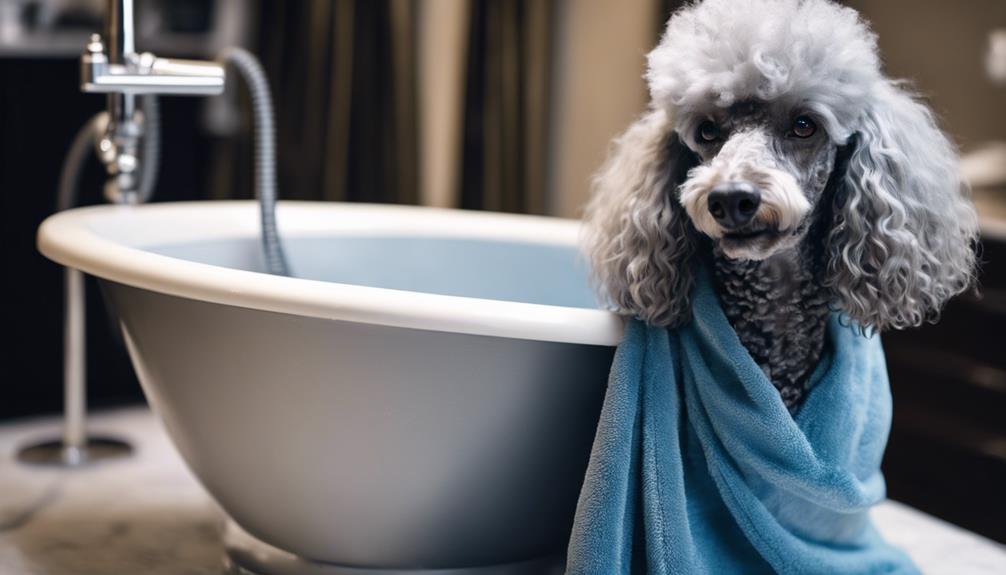
When bathing your silver or blue poodle, ensure to use a dog-specific shampoo at an appropriate water temperature. It's vital to rinse thoroughly to eliminate any shampoo residue that could impact the coat's color. Remember to dry your poodle gently with a low heat setting on a high-velocity dryer to maintain their skin and coat health.
Water Temperature for Bathing
Maintaining the ideal water temperature of around 100-102 degrees Fahrenheit is crucial for bathing silver and blue poodles effectively and ensuring their comfort throughout the process. When preparing the bath for your poodle, follow these guidelines for the perfect water temperature:
- Warm and Gentle: Ensure the water is comfortably warm, not hot, to prevent scalding your poodle's sensitive skin.
- Consistency is Key: Keep the water temperature consistent throughout the bath to avoid causing stress or agitation in your furry friend.
- Effective Penetration: The warm water helps open the hair cuticles, allowing for better absorption of shampoo and conditioner, resulting in a thorough clean and a healthy coat.
Proper Drying Methods
Ensuring proper drying methods is essential for preserving the distinctive coat texture of silver and blue poodles, maintaining their unique look and health. To protect their delicate coat, use a high-velocity dryer on a low setting, avoiding vigorous towel-drying that can cause tangling and matting. While drying, gently comb through the damp coat to ensure even airflow and prevent knots. Finish by using a slicker brush to fluff and style their coat, giving them a polished appearance. These steps will help maintain the coat texture of silver and blue poodles, keeping them looking their best and promoting their overall well-being. Remember, gentle care during the drying process is key to preserving their stunning coats.
Grooming After Bath
To ensure optimal grooming results after bathing your silver or blue poodle, utilize a high-velocity dryer for efficient coat drying. Here are key steps to follow for grooming after bath:
- Brush the Coat: Gently brush the coat in the direction of hair growth to prevent tangles and mats from forming.
- Use a Slicker Brush or Comb: Employ a slicker brush or comb to remove any remaining tangles or loose fur, ensuring a smooth and polished look.
- Trim as Needed: Trim the poodle's coat as necessary to maintain a tidy and manageable appearance.
Following these grooming steps post-bath will help keep your poodle looking its best and maintain a healthy coat.
Brushing and Detangling Tips
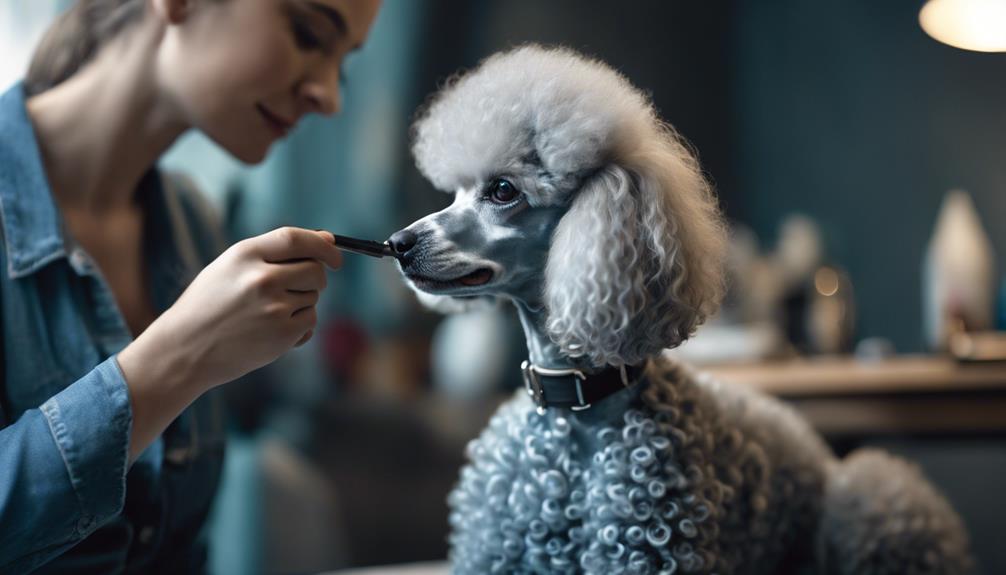
Brushing your silver or blue poodle with a slicker brush helps prevent matting and tangles in their coat, maintaining their overall health and appearance. When grooming your poodle, start brushing from the bottom of the coat and work your way up to prevent pain or discomfort, especially for older poodles who may have sensitive skin. Regular brushing not only detangles but also helps distribute natural oils, keeping the coat healthy and shiny.
To detangle effectively, work on small sections at a time using a comb. This method allows you to gently work out knots without causing breakage or discomfort to your furry friend. Additionally, incorporating a detangling spray or conditioner can make the brushing process easier and smoother for both you and your poodle. By following these tips, you can ensure that your silver or blue poodle's coat remains in top condition, promoting their well-being and showcasing their unique beauty.
Professional Grooming Considerations
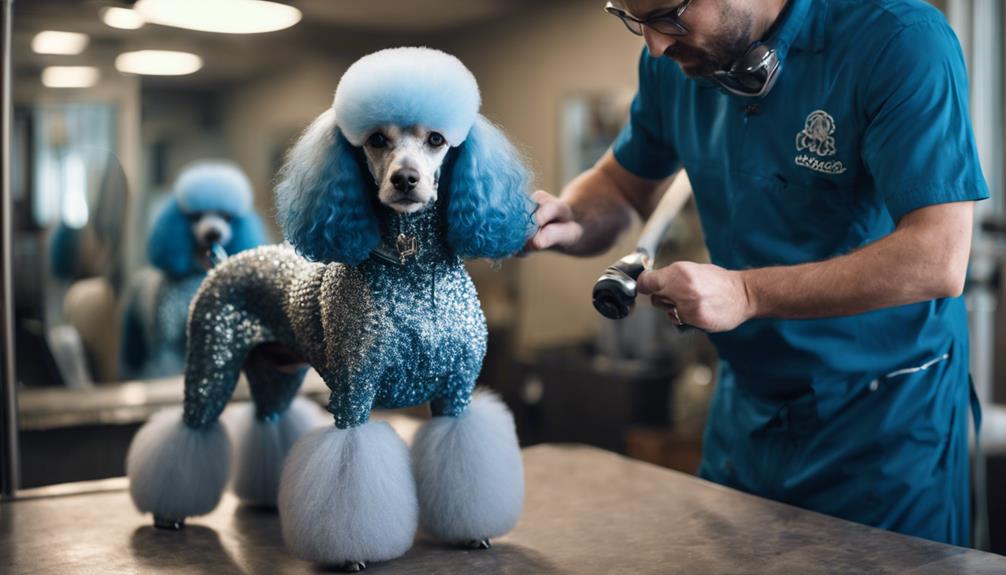
As you seek professional grooming services for your silver or blue poodle, keep in mind that maintaining their unique coat textures requires specific techniques and products tailored to their individual needs. Here are some essential considerations for professional grooming:
- Regular Brushing: Groomers recommend frequent brushing to prevent matting and keep the coat healthy. This helps distribute natural oils and prevents tangles that can lead to discomfort for your poodle.
- Specialized Techniques: Professional groomers use techniques like scissoring and clipping to maintain the distinctive textures of silver and blue poodle coats. These methods help achieve the desired look while keeping the coat in optimal condition.
- Tailored Products: Using specialized shampoos and conditioners can enhance the color and shine of your poodle's coat. These products are designed to meet the specific needs of silver and blue poodles, ensuring their coat remains vibrant and healthy between grooming sessions.
Maintaining Poodle Ear Hygiene
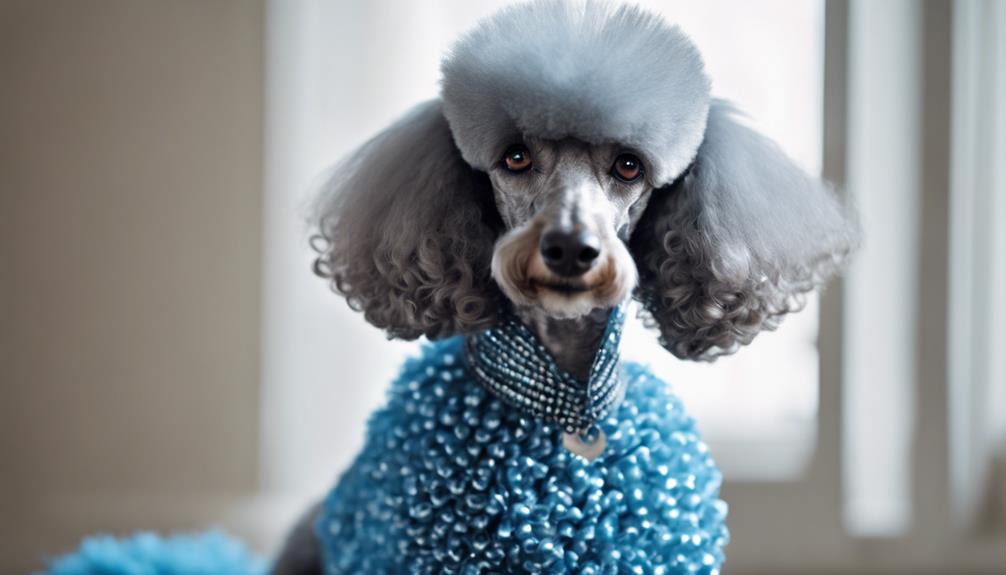
Regularly maintaining your poodle's ear hygiene is essential for preventing potential health issues and ensuring their overall well-being. As a dog breed known for their luxurious coats and distinctive appearance, poodles require special attention when it comes to ear care. Start by checking their ears regularly for any signs of dirt, wax, or debris accumulation. Using a gentle ear cleaning solution recommended by a veterinarian, gently wipe the outer ear area to keep it clean. Avoid using cotton swabs or inserting anything deep into the ear canal to prevent injury. It's crucial to watch out for signs of ear infections such as redness, swelling, odor, or excessive scratching. If you notice any unusual symptoms or changes in your poodle's ear health, seek veterinary advice promptly. By staying proactive and attentive to your poodle's ear hygiene, you can help them stay healthy and happy for years to come.
Nail Trimming Guidelines
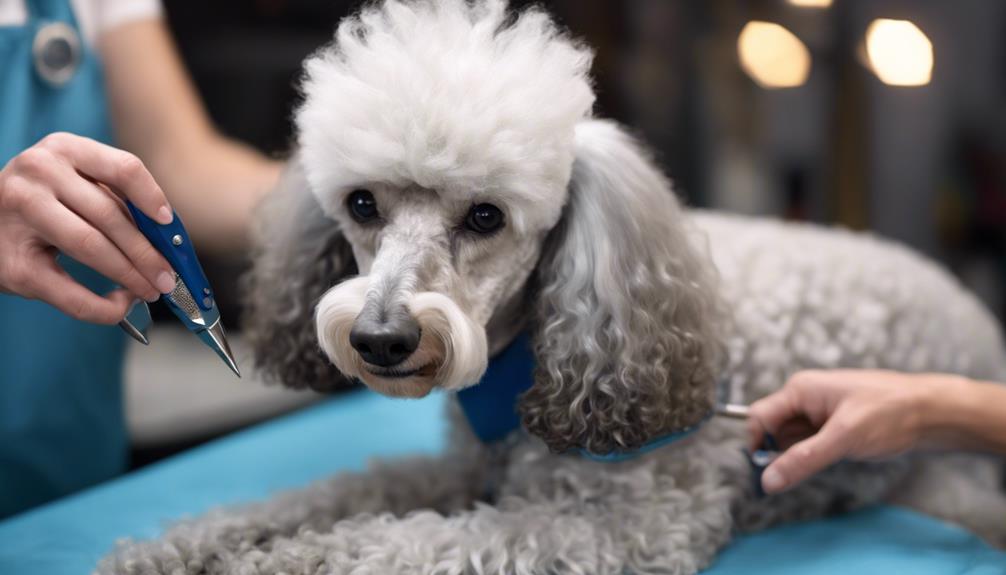
To maintain your poodle's overall health and prevent potential issues, it is crucial to adhere to proper nail trimming guidelines every 2-4 weeks. Follow these steps to ensure your poodle's nails are well-maintained:
- Gather the necessary tools: Use a sharp, quality nail trimmer designed for dogs to avoid splintering or crushing the nails.
- Trim with care: Cut just the tip of the nail, being cautious to avoid the quick (blood vessel) to prevent bleeding or pain.
- Seek professional advice: If you are unsure about the process, consider consulting a professional groomer or veterinarian for guidance on safe and effective nail trimming techniques.
Regular nail trimming is essential in preventing issues like splaying of the feet, discomfort, and potential injuries. By following these guidelines every few weeks, you can help keep your poodle healthy and happy for several months to come.
Dental Care for Poodles

Maintaining your poodle's overall health goes beyond nail trimming; ensuring proper dental care is crucial to prevent dental issues like tartar buildup, gum disease, and tooth decay. Poodles are prone to dental problems due to their small mouths, crowded teeth, and tendency to accumulate plaque. Brushing your poodle's teeth at least 2-3 times a week can help maintain good oral hygiene. Additionally, providing dental chews, toys, and treats designed for dental health can aid in reducing plaque and tartar buildup. Annual dental check-ups with a veterinarian are recommended to monitor your poodle's oral health and address any dental issues promptly.
Dental Care Tips for Poodles:
| Dental Care Tips | Frequency | Importance |
|---|---|---|
| Brushing | 2-3 times/week | Removes plaque and prevents tartar buildup |
| Dental Chews & Toys | Daily | Helps reduce plaque and freshens breath |
| Veterinary Check-ups | Yearly | Monitors oral health and addresses issues early |
Creating a Grooming Routine
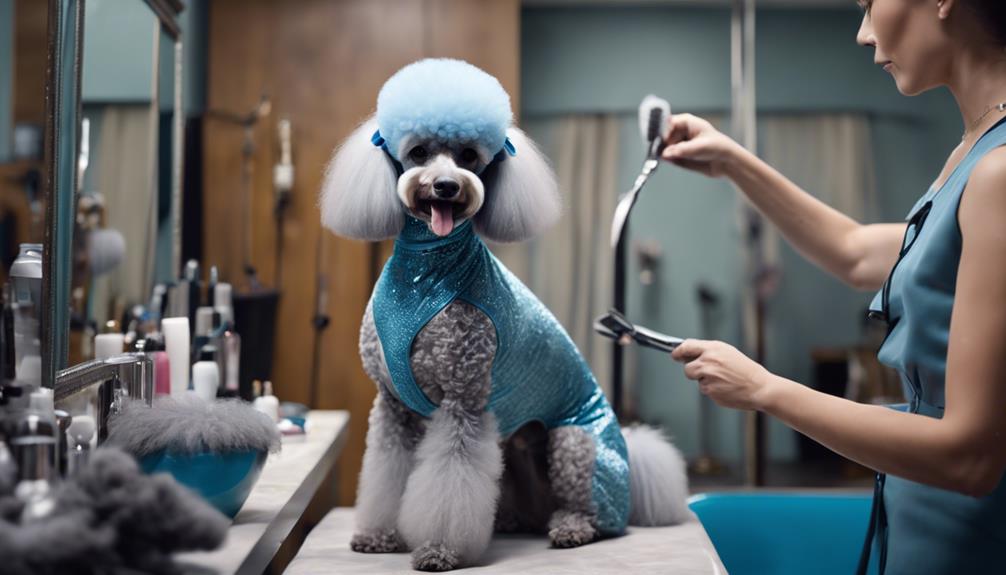
To establish a well-rounded grooming routine tailored specifically for silver and blue poodles, begin by understanding the unique needs of their coat color and texture. When grooming these elegant poodles, use high-quality tools and products designed for their coat type. Here are three essential steps to keep your silver or blue poodle looking its best:
- Regular Brushing and Combing: To prevent matting and tangling, make sure to brush and comb your poodle's coat regularly. This helps maintain the coat's texture and appearance.
- Color-Safe Baths: Incorporate regular baths using color-safe shampoos and conditioners to keep your poodle's coat clean and vibrant. This helps prevent color fading and maintains the unique look of silver and blue poodles.
- Professional Grooming Services: Consider professional grooming services for your silver or blue poodle, especially when getting shaved for the first time. Professionals can ensure proper coat maintenance and color preservation, enhancing your poodle's overall grooming experience.
Silver and Blue Poodles' Unique Charm
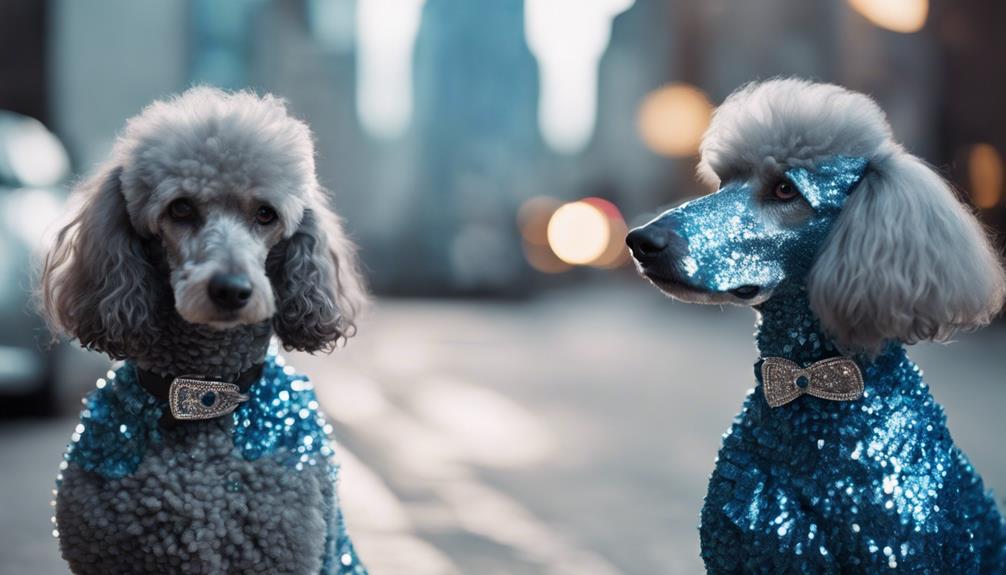
Silver and Blue poodles exhibit a captivating allure with their unique coat colors and distinct characteristics. Silver poodles boast a much paler hue compared to their blue counterparts. Blue poodles, on the other hand, take a longer time to develop their final color, adding to their mystique. Roxy, a lighter blue poodle, stands out amongst her silver counterparts like Dexter. Interestingly, some black poodles may mimic the fading of blue coats over time, revealing subtle shades of blue and white. Silver poodles tend to lighten faster than blue poodles as they age, showcasing a graceful transition in color. The interplay between the black and white variations within the silver and blue poodle breeds adds depth and complexity to their charm. Embracing the uniqueness of each coat color, these poodles enchant with their ever-evolving shades, making them truly exceptional companions for those seeking a touch of elegance in their lives.
Frequently Asked Questions
What Is the Rarest Color in Poodles?
The rarest color in poodles is silver, making it highly sought after among enthusiasts. Color genetics play a crucial role in determining this rarity. Silver poodles have a distinctive platinum-like appearance, adding to their allure.
At What Age Do Silver Poodles Turn Silver?
Around 2 years old, silver poodles typically begin their color transition, gradually developing their silver hue over 2-3 years. Factors like genetics play a role in this process. Observing the coat lightening indicates progress.
Do Silver Poodles Start Out Black?
Yes, silver poodles start out as black puppies due to the silver gene. The color transformation begins with a bright platinum face as puppies, gradually developing into a lighter, silver-grey coat over time.
What Does a Phantom Poodle Look Like?
A phantom poodle boasts unique markings called phantom markings, featuring a main color (silver or blue) with tan points on specific areas. These distinctive patterns give phantom poodles an elegant and sought-after appearance, setting them apart in the poodle world.
Conclusion
As you navigate the enchanting world of silver and blue poodles, remember to embrace their unique charm and distinct coat colors. By understanding the genetics, variations, and grooming needs of these majestic breeds, you can create a tailored grooming routine that highlights their beauty. With proper care and attention to detail, you can truly unveil the mystique of silver and blue poodles, showcasing their inner radiance for all to admire.
